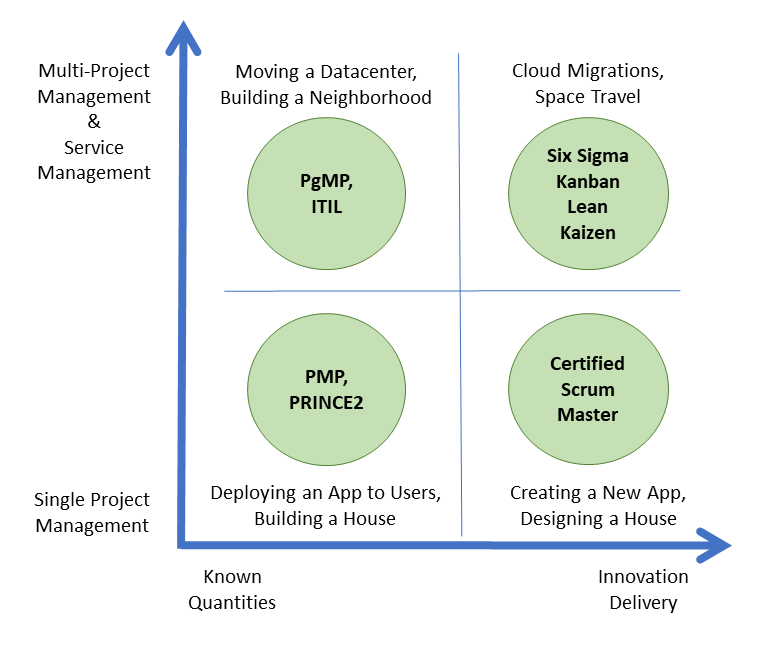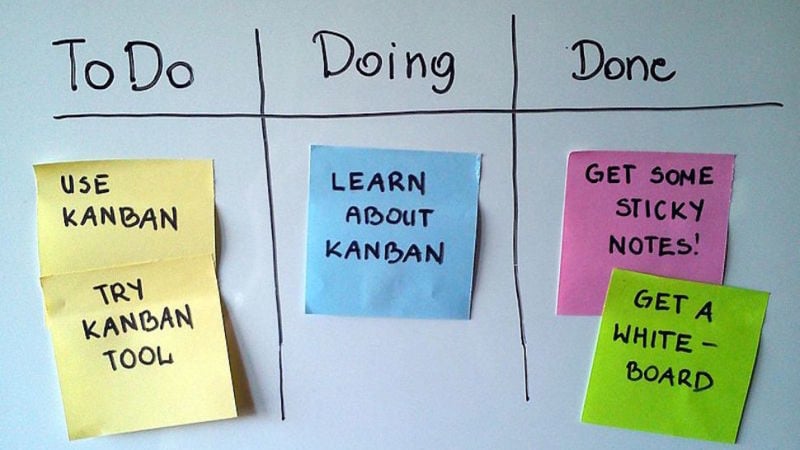It is increasingly difficult to determine how the different project/program/process certifications actually relate to different business aspects of agility or scope. When searching for a project manager, it’s easy to get lost in the alphabet soup after people’s names. If we draw a graph using scope and scale, then overlay the different certifications, it becomes much easier to see who’s particularly certified at what:

The purists will point out that the top right was originally just manufacturing/supply chain, but the use of Six Sigma and Lean have far-outgrown conveyor belts, valued heavily in any area of customer-driven service delivery. If you’re looking for more specific details about each certification, here’s a comparison and explanation of how the major certifications are attained and governed.
PMP
Project Management Professional (PMP) – The PMP is for anyone managing projects that have a defined start, end, budget, and deliverable(s). These are usually projects outside of software development, but often include the deployment of new software products. Project Management Institute (PMI) is the only official governing body for the PMP Certification. This is absolutely the most difficult and coveted certification to attain of the lot. You must have at least 4,500 documented project management hours (7,500 if you have less than 4 years of college), and you must attend 35 hours of in-classroom training from an accredited project management school.
Once you have these prerequisites, you apply to PMI for permission to test, and *if* your application is accepted after they vet and verify your credentials and experience, they’ll “invite” you to pay the ~$600 testing fee. The tests are proctored at specific physical testing locations that include security, surveillance, and metal detectors, and you must answer enough of the 200 questions correctly from memory in 4 hours, or you don’t pass. The questions are kept highly secret, and you’re not told what you failed, nor are you given an actual score, just whether you’re proficient in each area of project management or not. Ongoing maintenance is required as well, you must continue to accrue Professional Development Units (PDU’s) in order to maintain your PMP certification. To check if someone is current in their certification, PMI has this easy lookup tool: https://certification.pmi.org/registry.aspx
PRINCE2
Projects IN Controlled Environments (PRINCE2) – Notably similar to the PMP, but marketed as a “methodology” instead of the PMP’s “standard.” The governing body is the APM Group, or “APMG.” There are two levels, Foundation and Practitioner, and to take the Practitioner test, you must either be Foundation certified, or currently hold either a PMP or CAPM (like a mini-PMP) from PMI. The training and tests can be taken almost any way you want, including online, and it’s an open-book test. There are numerous training & testing companies to choose from to attain this certification. Axelos and the UK government are the two governing entities for the body of knowledge. Verifying certification holders is difficult.
https://www.axelos.com/certifications/prince2/prince2-practitioner-certification
ITIL
Information Technology Infrastructure Library (ITIL) – This certification has five levels; Foundation, Practitioner, Intermediate, Expert, and Master. ITIL is a framework that instructs an organization how to create IT departments and roles in a manner where business needs are aligned to specific departments within an information technology organizational structure. Everything from Change Advisory Boards, to the tiers of your helpdesk; ITIL has defined, prescriptive detail about which departments separately define, approve, and execute work. Of note- ITIL (and/or COBIT) are often used as governance frameworks to satisfy Sarbanes-Oxley requirements, but neither are blanket solutions, nor required by any law. Axelos and the UK government own this body of knowledge (like PRINCE2), testing sites must be accredited by them, it’s a closed book test, looking up certification holders is difficult.
https://www.axelos.com/certifications/itil-certifications
PgMP
Program Management Professional (PgMP) – This PMI certification is the next step above PMP, though rarely required by employers as most experienced PMP’s can offer the same depth and width of management expertise. It is also extremely difficult and expensive to attain with highly controlled, rigorous testing involved.
CSM
Certified Scrum Master (CSM) – The CSM is for anyone managing projects where very little is known, where the object is to deliver a testable product as quickly and inexpensively as possible, to enable rapid customer feedback as early as possible, and/or garner ROI in a new market as quickly as possible. This is usually software development, but spans supply chain and manufacturing fairly effectively. Scrum Alliance is the governing body for the Certified Scrum Master certifications, but you should be aware that there are many other very good certifications surrounding the Agile Methodology, of which PMI has their ACP certification which is new, but gaining momentum. To get your CSM, you must take 35 accredited classroom hours of training, and then take the 30-question test online with the Scrum Alliance. You can look up CSM certification holders here:
https://www.scrumalliance.org/community/certificant-directory
CSPO
The Certified Scrum Product Owner (CSPO) – certification is another Scrum Alliance certification for people who own the Product (capitalized deliberately) or deliverable being built by the Scrum Team managed by the CSM. Business-savvy Scrum Masters can perform this job, though technically not while also performing Scrum Master duties. It’s indeed a good idea to separate the Scrum Master role from the Product Owner role; this certification adds verification to a person’s ability to drive an Agile Scrum Product. Attaining a CSM is often a prerequisite for the CSPO.
Six Sigma
Six Sigma – is analysis and identification of bad variability in a repeating process. There are 3 main recognized certification levels (belts); Green, Black, and Master Black. Master Black Belts are 100% dedicated to statistical/mathematical analysis of manufacturing or business process and identifying project opportunities in the most complex environments for the Black Belts. It’s a lot of advanced math, and many companies employ Black Belts for this work since there is quite a bit of overlap.
Black Belts are Six Sigma project managers, they are responsible for identifying and reducing variability in specific processes, and then they are often responsible for bringing that process into tolerance/acceptance (a conveyor belt or software delivery automation system may be running perfectly but delivering identically broken things to the wrong endpoints with a very low rate of variability). Green Belts assist Black Belts with execution tasks. There’s no governing body for Six Sigma, nor is there a singular body of knowledge, and many different providers test for different belt levels at different prices, with open book, online tests, making it difficult to know what you’re getting when someone says they have a Six Sigma certification.
Kaizen, Kanban, & Lean
A “Kaizen Event” (pronounced ky-zen) – is typically no more than 1-week long where everyone involved with a process maps out a “Value Stream Map” of customer needs through customer satisfaction, where efficiency opportunities in every aspect of the organization, business unit, supply chain, and manufacturing process are identified. The person running this meeting needs to have the qualities of an MC, comedian, conflict resolution therapist, and Business Analyst. Not particularly in that order, but it makes the experience better. Kaizen then dovetails into Lean/Six Sigma in its quest for continuous improvement.

Image source: https://lifehacker.com/productivity-101-how-to-use-personal-kanban-to-visuali-1687948640
Kanban (pronounced con-bon) – is the art of providing services just in time, with as little waste or piled up resources as possible. The idea that every conveyor belt can only hold a certain amount of work in progress, and should be pulling product from the belt that feeds it is becoming very interesting in its application to software delivery and DevOps.
Lean – is very similar to Kanban and Six Sigma, in that everything in a process should be finely-tuned, have a specific purpose, and it should be clean and put back when you’re done using it. Lean is often added to Six Sigma training & certifications, resulting in a Lean Six Sigma Black Belt (LSSBB), etc. There are no governing bodies for these concepts, though Motorola and Toyota have certainly produced the most prolific advancements in the continual improvement methodologies, and receive credit for creating them.
If you have any other questions about various certifications or trying to match your business needs to the kind of staff you’re looking for, please reach out to us, we’re happy to help.
Information and material in our blog posts are provided "as is" with no warranties either expressed or implied. Each post is an individual expression of our Sparkies. Should you identify any such content that is harmful, malicious, sensitive or unnecessary, please contact marketing@sparkhound.com
Share this
You May Also Like
These Related Stories

What is the common stumbling block when adopting Agile methodologies?

Communicate with Purpose
